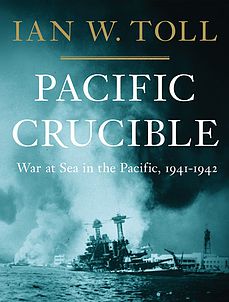'Pacific Crucible: War at Sea in the Pacific, 1941-1942' book review
 |
| (C) 2011 W.W. Norton |
On Sunday, December 7, 1941 – “a date which will live
in infamy” – a massive Japanese aerial armada swooped over Pearl Harbor and
struck a devastating blow against the U.S. Pacific Fleet.
Almost six months
later, four of the six aircraft carriers – Akagi,
Kaga, Soryu, and Hiryu – which
had launched those planes were
ambushed and sunk by American naval aviators at the Battle of Midway. In less
than 180 days, the battered but determined Pacific Fleet, commanded by a
soft-spoken and strategically savvy Texan named Chester W. Nimitz, halted the
seemingly unstoppable string of Japanese victories and gained the initiative in
the Pacific.
Ian W. Toll’s “Pacific Crucible: War at Sea in the
Pacific, 1941-1942” is a vivid and searing account of the early months of the
long, bloody and vicious struggle between the United States and Japan. In its
640 pages, Toll – a former Wall Street analyst, Federal Reserve financial
analyst, and a political aide and speechwriter – describes
“the planning, the strategies, the sacrifices and heroics – on both sides –
illuminating the greatest naval war in history”
with the mind of an historian and the narrative skills of a novelist.
Here, the author of the award-winning “Six Frigates:
The Epic History of the Foundation of the U.S. Navy” describes the initial
reaction of Oahu’s residents to the arrival of the first wave of Japanese
aircraft on that fateful Sunday morning in December 1941:
For the inhabitants of Oahu, there was nothing unusual in being jerked out of sleep by guns and bombs and low-flying aircraft. The island was crowded with military bases, and live-firing drills were commonplace. In early 1941, as the danger of war had seemed to grow, the services took to conducting "simulated combat exercises" — mock battles pitting the army against the navy, the navy against the marines, the marines against the army. On these days, a colossal amount of ammunition was thrown up into the air, and the island's lightly built wood-frame houses would shake and rattle as if an earthquake had struck. So when the familiar racket started up, at a little before eight in the morning on that first Sunday in December 1941, most of the residents pulled a pillow over their heads, or turned back to their coffee and comic strips and radio programs, and tried to ignore the deep concussive thuds of distant bombs, the heavy booming of antiaircraft batteries, and the faint rat-a-tat-tat of machine guns.
“Pacific Crucible” tells
the dramatic story of Japan’s blitzkrieg in Southeast Asia and across the vast
expanses of the world’s largest ocean and the Allies’ struggle to recover from
a series of defeats by a tough and determined enemy. Toll uses eyewitness
accounts and primary sources to describe the attack on Pearl Harbor, the fall
of Singapore, the loss of Britain’s proud battleships Prince of Wales and Repulse, Japan’s
conquest of the Philippines and the Dutch East Indies (present day Indonesia).
Toll also covers the early phase of the Pacific War from every perspective,
including ordinary seamen and such legendary admirals as Nimitz, William
Halsey, Raymond Spruance, Chuichi Nagumo, and the flamboyantly brilliant
Isoroku Yamamoto, who planned the daring Pearl Harbor attack and the ill-fated
campaign to capture Midway Island in June of 1942.
“Pacific Crucible: War at
Sea in the Pacific, 1941-1942” is a highly readable book. Toll uses the latest
information available about the early dark days of America’s entry into World War
II to bust some long standing myths, especially several misconceptions about
the Battle of Midway, that have been perpetuated by earlier accounts of the
Pacific War. The book explains how and why Japan decided to provoke a war that
many of its senior commanders – including Yamamoto – knew she could not win.
Using clear and lively prose and an eye for vivid details that makes history
come alive, Toll gives the reader a page-turner that is hard to put down.
Originally published in
2011, “Pacific Crucible” is the first volume of a trilogy about naval warfare
in the Pacific. The second volume, “The Conquering Tide: War at Sea in the Pacific
Islands, 1942-1944” was published by W.W. Norton in 2015 and covers the period
between the six month-long campaign for Guadalcanal and Japan’s crucial defeat
in the Marianas in the summer of 1944. The trilogy’s conclusion, “Twilight of
the Gods: War at Sea in the Western Pacific, 1944-1945” will be published in July of 2020.

.jpg)

Comments
Post a Comment